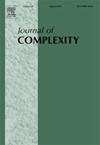基于状态的抛物型分布最优控制问题的时空有限元系统最优复杂性解
IF 1.8
2区 数学
Q1 MATHEMATICS
引用次数: 0
摘要
本文考虑一个以抛物型演化方程为约束的分布式最优控制问题。本文提出的方法是基于各向异性Sobolev空间中抛物演化方程的变分公式,考虑了[H0;,01,1/2(Q)]中的控制。由于状态方程定义了从H0;0,1,1/2(Q)到[H0;, 1,01,1(Q)]的同构,我们可以消除控制,最终得到H0;0,1,1/2(Q)的最小化问题,其中各向异性Sobolev范数可以使用修改的Hilbert变换来实现。在无约束情况下,最小解是奇摄动椭圆方程的唯一解。在时空张量积网格的情况下,我们可以使用稀疏分解技术来构造几乎线性复杂度的求解器。数值例子还包括附加状态约束和非线性状态方程。本文章由计算机程序翻译,如有差异,请以英文原文为准。
Optimal complexity solution of space-time finite element systems for state-based parabolic distributed optimal control problems
In this paper we consider a distributed optimal control problem subject to a parabolic evolution equation as constraint. The approach presented here is based on the variational formulation of the parabolic evolution equation in anisotropic Sobolev spaces, considering the control in . Since the state equation defines an isomorphism from onto , we can eliminate the control to end up with a minimization problem in where the anisotropic Sobolev norm can be realized using a modified Hilbert transformation. In the unconstrained case, the minimizer is the unique solution of a singularly perturbed elliptic equation. In the case of a space-time tensor-product mesh, we can use sparse factorization techniques to construct a solver of almost linear complexity. Numerical examples also include additional state constraints, and a nonlinear state equation.
求助全文
通过发布文献求助,成功后即可免费获取论文全文。
去求助
来源期刊

Journal of Complexity
工程技术-计算机:理论方法
CiteScore
3.10
自引率
17.60%
发文量
57
审稿时长
>12 weeks
期刊介绍:
The multidisciplinary Journal of Complexity publishes original research papers that contain substantial mathematical results on complexity as broadly conceived. Outstanding review papers will also be published. In the area of computational complexity, the focus is on complexity over the reals, with the emphasis on lower bounds and optimal algorithms. The Journal of Complexity also publishes articles that provide major new algorithms or make important progress on upper bounds. Other models of computation, such as the Turing machine model, are also of interest. Computational complexity results in a wide variety of areas are solicited.
Areas Include:
• Approximation theory
• Biomedical computing
• Compressed computing and sensing
• Computational finance
• Computational number theory
• Computational stochastics
• Control theory
• Cryptography
• Design of experiments
• Differential equations
• Discrete problems
• Distributed and parallel computation
• High and infinite-dimensional problems
• Information-based complexity
• Inverse and ill-posed problems
• Machine learning
• Markov chain Monte Carlo
• Monte Carlo and quasi-Monte Carlo
• Multivariate integration and approximation
• Noisy data
• Nonlinear and algebraic equations
• Numerical analysis
• Operator equations
• Optimization
• Quantum computing
• Scientific computation
• Tractability of multivariate problems
• Vision and image understanding.
 求助内容:
求助内容: 应助结果提醒方式:
应助结果提醒方式:


